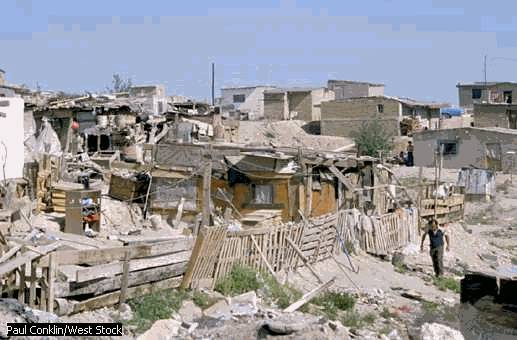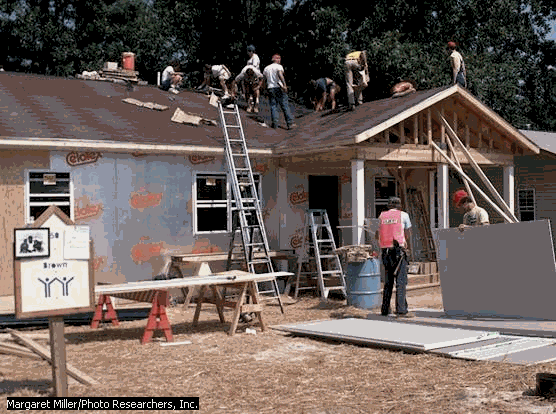2202111 English One
Unit 1 Supplemental Reading
Housing In General
(1) Housing means permanent shelter for human habitation. Because shelter is
necessary to everyone, the problem of providing adequate housing has long been a concern,
not only of individuals but of governments as well. Thus, the history of housing is
inseparable from the social, economic, and political development of humankind.
HISTORY
(2) From the beginning of civilization, attention has
been paid to the form, placement, and provision of human habitation. The earliest building
codes, specifying structural integrity in housing construction, are found in
the ancient Babylonian Code of Hammurabi. City planning activities during the Greek and
Roman empires centered less on strength and much more on the appropriate placement of
urban housing from the perspectives of defense and water supply. These same concerns
continued throughout the Middle Ages.
(3) In 13th-century Europe, the city became a center of trade, and its
walls provided a safe haven from nomadic warriors and looters. People could
find shelter for themselves and their flocks, herds, and harvests while the open country
was being overrun by wandering enemy armies and dangerous thieves. Demand for urban
housing increased. For centuries this demand was filled by unplanned additions to, and
subdivisions of, existing structures. Where climate permitted, squatting
(occupying without title or payment of rent) became commonplace, but provided only
temporary shelter.
(4) By the 19th century, with the Industrial Revolution, people were moving to cities
in unprecedented numbers. Workers lived in sheds, railroad yards, and _______________,
typically without sanitation facilities and water supply.
(5) In the postindustrial society of the 20th century, housing in developing nations
and poor parts of developed countries continues to be of insufficient quality and does not
meet the demand of some parts of the population. Vacant, abandoned central-city housing
exists alongside structures that are usable but overcrowded and buildings that are
structurally reclaimable but are functionally obsolete.
 |
Slum in Mexico (left)
Poor people in many countries live in crowded slums and shantytowns, which often have
no electricity, running water or sewage systems. In this slum in Ciudad Juárez, a city in
Mexico just south of the U.S. border, some people have built their makeshift
houses from whatever materials they can find. |
(6) At present, there is both a demand for housing and a supply of reusable
structures that are going unclaimed. This situation is a good example of the complex role
housing plays in society. Its primary function was to serve the need for shelter and
privacy, but housing must now offer other advantages: (1) location, including proximity to
the workplace, shopping, businesses, schools, and other homes; (2) environment—that
is, the quality of the neighborhood, including public safety and aesthetics; and (3)
investment potential, or the degree to which home ownership may affect capital
accumulation.
FUTURE TRENDS
(7) Housing is a critical component in the social and
economic fabric of all nations. No country is yet satisfied that adequate housing has been
delivered to the various economic groups that make up its populace. Thus, most nations, in
one form or another, continue to claim a housing problem.
(8) In the 1990s in many parts of the United States a shortage of affordable housing
existed for the poor and for some low- and middle-income wage earners. Both rental and
owner-occupied homes were affected. Homeless people lived in shelters or on the streets,
especially in the cities, while at the same time residential buildings, both private and
public, in some crime-ridden neighborhoods were being abandoned. Most inner cities were
losing population as suburban areas continued their rapid, sometimes chaotic growth. In
all areas housing was being developed to meet the needs of the disabled as well as of the
elderly. Progress in factory-built housing offered the hope that inexpensive homes could
be mass-produced.
(9) Federal, state, and local governments continued to look for
solutions to U.S. housing problems. Rehabilitating public housing, selling subsidized
units to tenants, organizing public-private partnerships, amending zoning restrictions,
and issuing housing vouchers have all been proposed.
(10) Other countries face somewhat different problems. Britain and much of Western
Europe grappled with suburbanization and the decentralization of cities. In the former
USSR and in Eastern Europe, demand for more private dwelling space has increased. In the
Third World, raw housing demand is still largely unmet, as more people move to the
overcrowded cities. The shantytowns built by these migrants on the outskirts
of many cities often have no electricity, running water, or sewage systems.
| Questions: 1. Is there one sentence in the text
that expresses the main idea for the whole article? If so, which one? If not, write your
own sentence.
2. To organize her article, the writer…
- explains a process from first step to last step.
- presents her reasons from least to most important.
|
 |
c. discusses events
from the past to the present.
d. lists similarities and then differences.3. What are two reasons, mentioned in the article,
that the population of cities has grown?
4. . "These same concerns" (paragraph 2) refers to…
5. Which of the following explains the use of the definite article --"the
city" -- in paragraph 3?
- with names of rivers, oceans or seas
- with the names of places that include of
- when it is clear there is only one
- with singular countable nouns when they stand for a species, group or
institution with superlatives
6. Is "squatting" usually legal? (Paragraph 3)
7. What did ancient city planners have to consider? What might today's city planners
have to consider?
8.Which of the following best completes the blank in Paragraph 4? How do you know?
- government flats
- factory cellars
- private hotels
- farm buildings
9. Was U.S. housing a stable or changing industry in the 1990s? Why?
10. Paragraph 8 mentions housing problems faced by the United States a decade ago. Are
these problems similar to or different from the housing problems facing Bangkok today?
Give one example to support your answer.
11. "…organizing public-private partnerships, amending zoning restrictions…"
are examples of…..
12.Using context clues, write definitions for these words:
- integrity (paragraph 2)
- looters (paragraph 2)
- makeshift (photo caption)
- shantytown (paragraph 10)
13. Give three examples of housing problems that countries other than the U.S. have to
face.
14. Do you think the writer of the article is hopeful or not hopeful about solving
housing problems in the future? Explain your answer, making reference to information in
the text. |

